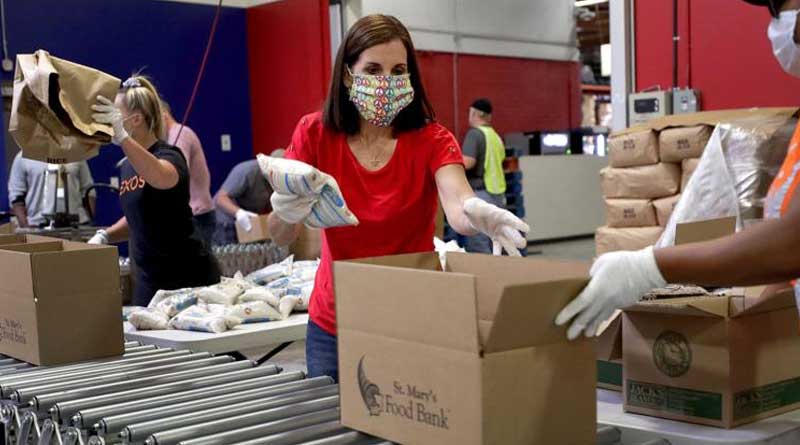Photo: U.S. Sen. Martha McSally, R-Ariz., packs food boxes at St. Mary’s Food Bank Friday, April 10, 2020, in Phoenix. Arizona. McSally is pinning the blame for the coronavirus outbreak on China and the World Health organization, while her likely Democratic rival, Mark Kelly, is pushing President Donald Trump to more aggressively force U.S. companies to produce medical supplies.
Photo Credit: AP Photo/Matt York
The Center Square [By Bethany Blankley]-
As 2020 winds down, roughly 23 percent of households in the U.S. are struggling with food insecurity, a number that has doubled since last year.
Experts project over 50 million Americans will be food insecure in 2020, including roughly 17 million children, Craig Gundersen, a Department of Agricultural and Consumer Economics professor at the University of Illinois, says.
In 2019, roughly 13.7 million U.S. families – 10.5 percent of households – experienced food insecurity at some point, according to the U.S. Department of Agriculture. Since state-mandated shutdowns began in most states in mid-March, the number of U.S. families experiencing food insecurity has roughly doubled, a number which coincides with high unemployment.
According to estimates published by researchers at Northwestern University, food insecurity has impacted as many as 23 percent of all U.S. households so far in 2020.
Households that have food security are defined as those who have access at all times to enough food for an active, healthy life for all household members, the USDA states.
Food insecurity in households includes those who are uncertain of having, or unable to acquire, enough food to meet the needs of all their family members because they have insufficient money or other resources to purchase food.
The most food insecure households are those with children headed by a single woman, followed by households with incomes below 185 percent of the poverty threshold. The federal poverty line was $25,926 for a family of four in 2019.
From April to July 2020, roughly 22.5 percent of all respondents to a U.S. Census Bureau Household Pulse Survey, and 29.3 percent of respondents with children, reported experiencing food insecurity conditions.
Gundersen developed Map the Meal Gap, an interactive model designed for Feeding America, a national network of more than 200 food banks in the U.S.
For his most recent report, Gundersen combined MMG data with projected unemployment numbers.
“One of the key things about COVID-19 is how there’s differential impacts across the country and by demographic groups,” Gundersen said. “People with college education generally have not seen much of an impact on either unemployment rates or incomes. However, people in lower-wage jobs tend to be impacted a lot more.”
States with the highest food insecurity levels before the coronavirus also had the highest food insecurity levels after the virus, but were worse.
According to the Northwestern study, the state with the least number of food insecure residents is Vermont (14.2 percent). Mississippi has the highest (30.8 percent).
The second-highest number of food insecure families lives in New Mexico (29.3 percent), followed by Louisiana (29.1 percent), Texas (28 percent) and Arkansas (27.9 percent).
To meet the demand for food and lack of resources to purchase it, well over 100 million food boxes will have been distributed to support U.S. farmers and families with food insecurity through the USDA’s Farmers to Families Food Box Program by the end of the year.
The USDA’s Agricultural Marketing Services has partnered with national, regional and local distributors “whose workforces have been significantly impacted by the closure of restaurants, hotels and other food service businesses,” the USDA says, to purchase fresh produce, dairy and meat products from American producers to the tune of $4 billion.
The program has supplied food boxes of fresh fruits and vegetables, dairy and meat products, and a combination box of fresh produce, dairy or meat products in partnership with state departments of agriculture nationwide. Distributors pack the products into family-sized boxes and transport them to food banks, community and faith-based organizations, and other nonprofit organizations working directly with families in need.
From May 15 to June 30, the USDA invoiced 35.7 million food boxes nationwide. From July 1 to August 31, the number increased to 50.8 million food boxes.
From Sept. 1 to Sept. 18, 15.1 million food boxes were delivered, and from Sept. 22 to Oct. 31, 17.2 million food boxes were invoiced.



